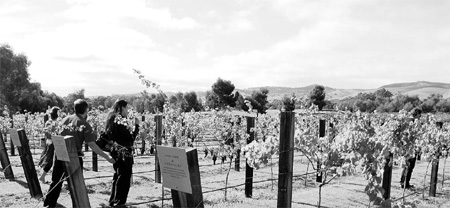Beautiful barossa
By Joni Ng Yi-wen (China Daily)
Updated: 2010-08-16 11:52
 |
Large Medium Small |

In South Australia, the name Barossa has become synonymous with the best food and wine. Joni Ng Yi-wen goes on a gourmet tour and samples a 100-year old vintage at Seppeltsfield.
Iconic wines, gourmet food producers, panoramic scenery and travel-friendly weather. These are just some of the reasons the Barossa Valley attracts hordes of thirsty and hungry travelers each year. It is a major wine-producing region 60 kilometers northeast of Adelaide, a mere hop away in the vastness that is Australia. In the distant days when the country was still a fledgling colony, the fertile soils and ample rivers of the Barossa attracted immigrants from both Britain and Germany. Other European settlers also arrived ?including one of the most famous names in Australian winemaking, the Seppelts from Poland.
Tobacco and liqueur merchant Joseph Seppelt came to the Barossa looking for land to grow tobacco. Instead, he founded one of Australia's oldest wineries in 1851 and began a tradition that continues today - the laying down of fine tawny port vintages.
Port is a sweet fortified wine much loved by middle-European settlers, especially the Polish and Czech communities that established themselves throughout Australia and New Zealand.
The Seppeltsfield cellars hold about nine million liters of fortified wines today, a collection that started in 1878 when Benno Seppelt, the eldest son of Joseph, selected a 500-liter barrel of port and gave instructions to mature it for 100 years.
The first centennial Para Tawny was released in 1978 and soon became the signature vintage of Barossa's best known winery, the only one to have significant amounts of port set aside in consecutive vintages for 100 years.
Our first taste of the 100-year old port came after a full day of good food and fine wines. We were going to be treated to the 1910 Para 100-year-old Vintage Tawny and would be some of the first people to taste the vintage.
The Seppeltsfield entrance is guarded by signature twin rows of palms lining the driveway. The colonial buildings, the shady paths and the cobblestone walkways quieted our chatter as we took in the historic estate.
Nostalgia greeted us in the welcoming living room. We had expected wines on the table, but the fuchsia pink glasses neatly laid out were filled with Seppeltsfield's famous raspberry cordial. It was an old school drink with a gush of sweetness followed by a strong aftertaste of raspberry that lingered on the palate.
After a day of vineyard visits, this was a refreshing change.
We stayed with our cordial in the living room of the original family homestead and listened to the story of the Seppelt family - from their migration, to their settling by the Para river, to the vineyards of today. Then we went to a regal dining area, set up for our port tasting session.
First up was the Para 1989 21-year Vintage Tawny. It had an orange blossom and brown spice bouquet, leaving the palate with a clean acid balance and nutty finish.
Next, the DP 90 Rare Tawny sent up a bouquet of oak and spice. It is a blend with quite a bit of finesse and complexity and a long, dry finish.
The Rare Tokay, using the traditional term, has a sweet caramel coffee and toffee flavor. With its complex mix, this blend leaves a clean, lifted finish on the palate. We finished the tasting with a final glass of Rare Muscat. All four vintages are best enjoyed with either dessert or a good cheese platter.
We enjoyed the blends, but the best was yet to come.
The tray of 1910 Para 100-year-old Vintage Tawny was undoubtedly the highlight of the day.
The Seppeltsfield Para Tawny has retained remarkable consistency of style and character over the years. For a wine so much older than most of us, it is extremely sweet and so concentrated that the acidity balances with a surprising freshness and vibrancy.
You can also taste your birth-year vintage at Seppeltsfield and sip it as you walk the longest lineage of single vintage wines in the world.

Apart from the Seppeltsfield fortified wines, the Barossa Valley is well-known for its red wines, especially its Shiraz grapes. Other varieties that enjoy fame in the valley are the Rieslings, the Grenache and the ubiquitous Cabernet Sauvignons.
Fine wines deserve good food and the Barossa delivers with food producers such as its most famous cook, Maggie Beer - television presenter, writer, restaurateur and now producer of a range of gourmet pates, fruit preserves and vinegars.
She also single-handedly revived the use of verjuice, a grape vinegar that had been overshadowed by the popularity of balsamic. Her quince paste is another signature product.
Barossa celebrates its quality producers with a Vintage Festival held each year that showcases local food and wine, and local choirs and bands. It is also a strong promoter of the Slow Food movement, in which recognition of origin is important.
